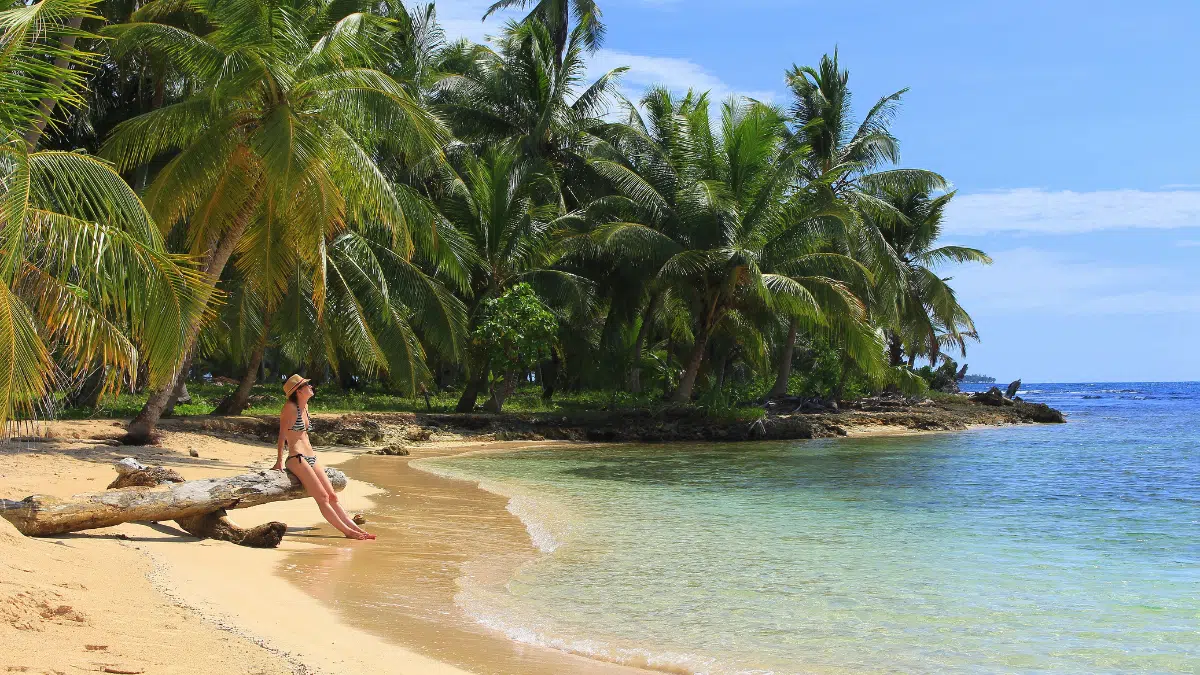Backpacking Panama in 2024: Ultimate First-Hand Guide
Often overlooked for popular next-door neighbors like Costa Rica and Colombia, Panama is actually one of the best countries for backpacking in Central America. It’s a paradise for adventure travel, with plenty of natural beauty to explore, including lush jungles, exotic wildlife, and remote Pacific and Caribbean islands.
Learn from our first-hand Panama backpacking experience: from bustling Panama City to chill Boquete, there’s plenty to see and do in Panama. Read on for all the best places to visit in Panama and itinerary ideas for one to two-week Panama backpacking experiences – plus all the money-saving tips you’ll need for the experience.

This post contains affiliate links that may reward me monetarily or otherwise when you use them to make qualifying purchases – at no cost to you. As an Amazon Associate, I earn from qualifying purchases. For more information, please read our disclosure policy.
Backpacking Panama
Panama is so much more than just Panama City and the Panama Canal, though these are destinations you’ll definitely want to visit on your trip. With endless opportunities for adventure travel through lush jungles and hiking past soaring waterfalls, it feels much like Costa Rica but costs just a fraction of the price to explore.
Like Colombia, it boasts gorgeous colonial cities (Panama City’s Casco Viejo is much like Cartagena, but before it became overrun with tourists), great food, and stunning beaches. Its very own San Blas Islands give Colombia’s Rosario Islands a run for their money and win out every day.
Most backpackers will want to spend at least two weeks or more exploring all Panama has to offer. Stick to the main cities in Panama, and two weeks will easily fill your itinerary, but with a little bit more time, you’ll be able to get off the beaten path and enjoy even more.
Read More: 25 Best Cities in Latin America for Travelers
Best Places to Visit in Panama
1. Bocas Del Toro
Located near the border of Costa Rica, Bocas Del Toro is the definition of a backpacker island. Many travelers who visit Panama overland via Costa Rica make it the first stop on their Panama itinerary, as the island is only a short bus/boat ride away from the border.
Aside from having the pristine beaches and tranquil shores you’d expect from any Caribbean island, Bocas del Toro has tons of water sports, including snorkeling, diving, and surfing. It’s where I first learned to surf, which I continue to do around the beach towns around Puerto Vallarta.
While Bocas del Toro is a popular destination on all Panama backpacking itineraries, it doesn’t feel overrun or overcrowded – not by a long shot. Most of the island is jungle, so one of the best things to do there is rent an ATV and go exploring. There’s even an island you can visit named Sloth Island, home to adorable smiling sloths.
Where To Stay in Bocas del Toro
If you want to be close to nightlife and restaurants, then the best place to stay is right in Bocas Town. These are some of the best places to stay in this area of town:
- Selina Bocas del Toro ($ – $$)
- Bambuda Lodge ($ – $$)
If you’re looking for quieter options and have more of a budget to work with, head over to Isla Bastimentos, where most of the luxury hotels are in Bocas del Toro. Here you’ll also find some affordable options, such as the Selina on Red Frog Beach.
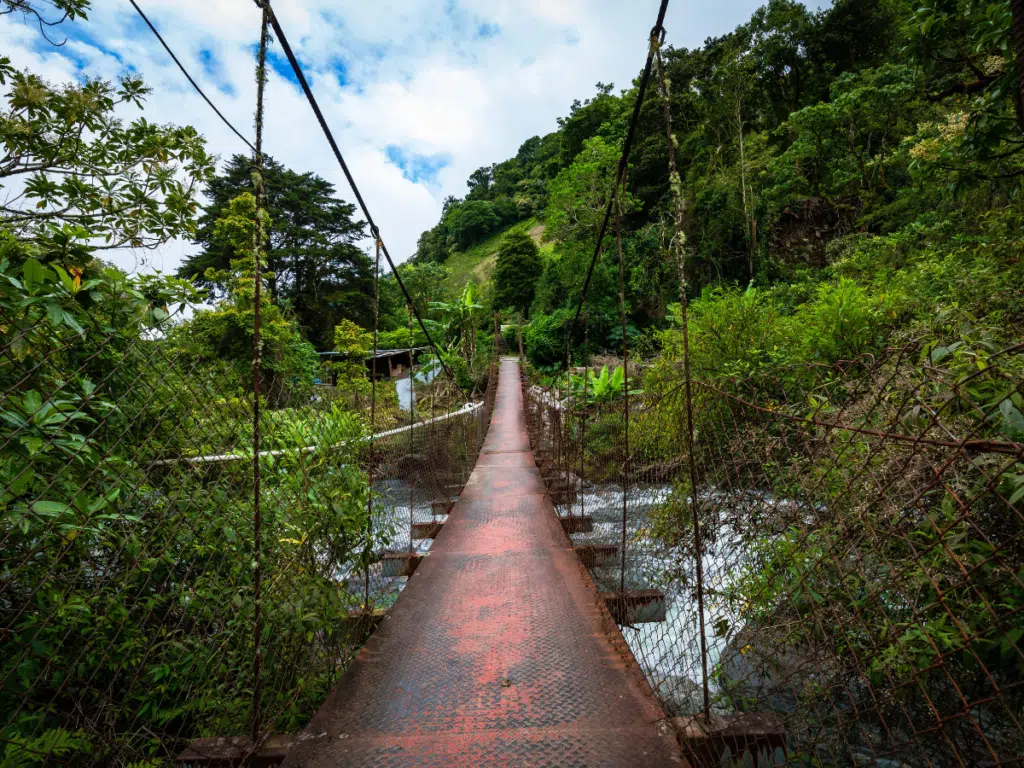
2. Boquete
If you’re looking for adventure in Panama, Boquete is the place to be. Located in the highlands of Panama, Boquete is a gorgeous town with opportunities for hiking, rafting, zip-lining, and even more relaxing activities like visiting hot springs.
The most popular hike in the area is to Volcan Baru, where you can see an incredible sunrise over both the Caribbean Sea and the Pacific Ocean. This hike is no easy feat; it involves leaving at midnight and hiking in the dark. However, the payoff is well worth it.
If you’re looking for a more accessible place to go hiking, check out the Lost Waterfalls trek in the area. This gorgeous trail takes you through the lush jungle, where you can see three beautiful waterfalls. It reminded me of the hiking trails around Puerto Vallarta, surrounded by lush jungle.
Boquete is also well known for its coffee, as it produces some of the most high-end coffee in the world. One of the best things to do in Boquete is to join a coffee tour to learn how coffee is produced in the region – it’s an activity that even those who aren’t coffee fans will find fascinating.
Where To Stay in Boquete
Boquete is home to one of my all-time favorite hostels: Bambuda Castle. It’s literally a castle but with hostel prices. It’s further out of town but has the most amazing views of Boquete.
Looking for more places to stay in Boquete? These are some more local favorites with Panama backpackers:
- Bambuda Castle ($)
- Selina Boquete ($ – $$)
- Villa Alejandro ($ – $$)

Getting to Boquete
To visit Boquete, you’ll have to get to the city of David first. Accessible by either flight or bus, there are several ways to reach David, whether via Panama City or beyond. I took the bus from Bocas Del Toro to David (about four hours) and then took the bus to Panama City afterward (about eight hours)
Boquete is just 25 minutes from David, accessible either by bus or taxi hire. David is mainly used as a transit city. You can spend a night or two in David, but it’s not a popular spot on the Panama backpacker trail.
If you’re looking for somewhere to visit between Bocas Del Toro and Boquete to break up the journey, check out the Lost and Found Hostel in the heart of the cloud forests in the Chiriquí Province. It’s one of the most unique (and popular) hostels in Panama!
Travel Essential
Don’t think about traveling without a good VPN (Virtual Private Network). Using a VPN while connecting to the internet is an easy way to keep your personal information safe from hackers and trackers. We’ve used NordVPN for years and couldn’t recommend it more – it’s a must for safety online, at home or abroad.
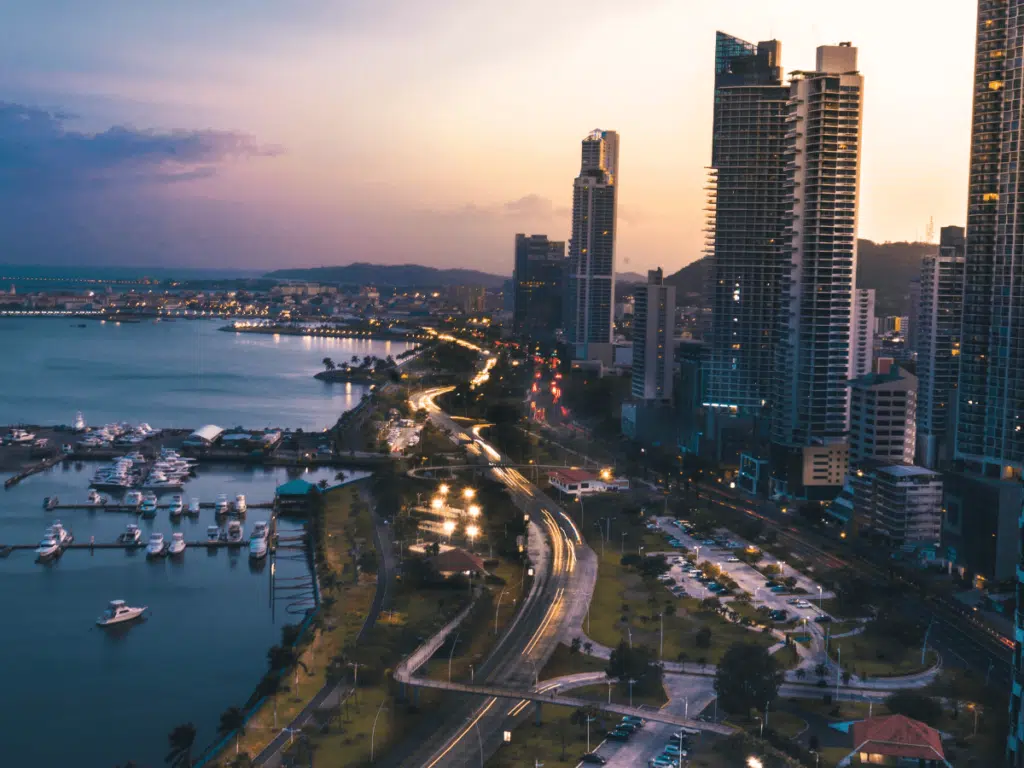
3. Panama City
Big cities in Central America tend not to have much to offer for travelers, though Panama City is a huge exception. This vibrant city has many fun things to do and is well worth spending a few days exploring.
One of my favorite things to do in Panama City was renting bikes and cycling around the water. There are awesome biking and walking trails directly along the water where you can get views of both historic (Casco Viejo) and new areas of Panama City. The Casco Viejo now has more to offer than ever, with an increasingly impressive array of hotels, cafes, restaurants, and bars to fall in love with.
Of course, Panama City is most famous for the Panama Canal. Take a guided tour of the Panama Canal from Panama City – you’ll find plenty of affordable excursions, and some hostels even offer cheap group tours for guests.
After spending the months backpacking Central America, I felt oddly out of place here showing up to bars and clubs in my Birkenstocks. If you want to get dressed up, there are also plenty of places to go shopping in Panama City – it’s the shopping capital of Central America.
Where To Stay in Panama City
While most backpackers will want to stay in the heart of Panama City’s historic center – known as the Casco Viejo or Casco Antiguo – prices here can be a bit higher. Though everything will be quite walkable and impressively beautiful, areas like Obarrio will be more affordable – check out our guide to where to stay in Panama City for even more details.
- Selina Casco Viejo ($)
- Machico Hostel ($)
- Global Hotel Panama ($ – $$)
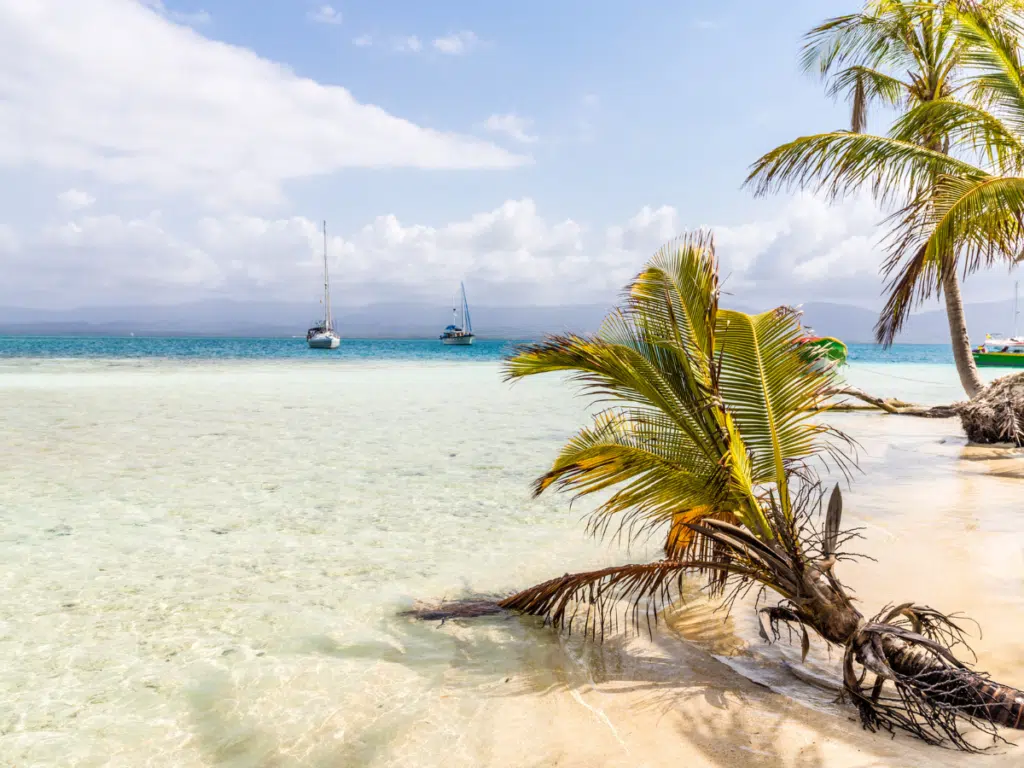
4. San Blas Islands
Perched in the Caribbean Sea near the Panama-Colombia border, the San Blas Islands are some of the most impressive and beautiful highlights of any visit to Panama. If you’re looking for an affordable Caribbean island getaway, this is where you’ll find it.
Many visitors explore the San Blas Islands as a way to travel “overland” between Colombia and Panama or visa versa – you’ll find tour providers offering the experience departing from both sides of the border. Even if you’re not traveling onward to Colombia, you can visit the San Blas Islands for a couple of days from Panama City, which is well worth it.
Picture untouched spits of sand with a brush of palms fringing the shores: this is what the postcard-perfect San Blas Islands look like. Days on the islands are spent snorkeling (we saw huge manta rays), relaxing on the beach, playing games, eating amazing seafood, and drinking. The locals sell beer on the islands, and you can also bring your own alcohol.
To travel from Panama to Colombia via the San Blas Islands, you can take a speed boat with San Blas Adventures (4 days) or a sailing boat (5 days). I did the speed boat tour and highly recommend it because you spend way more time on the islands and less at sea.
Where To Stay in the San Blas Islands
There are plenty of places to stay in the San Blas Islands, though, for the most part, they tend to be quite rustic and a bit more expensive than they would be in other areas of the country. However, for a truly dreamy Caribbean island experience on a budget, they can’t be beat.
These are some places to consider staying on the islands:
- Ina Cabins ($$)
- Anbabnega Lodge ($$)
Travel Guide to Colombia

5. Playa Venao
Tucked away in the jungle on the less-visited (but stunningly beautiful) western coast of Panama is a tiny surf town called Playa Venao. This sandy, crescent-shaped stretch of beach with just one street of shops and restaurants is the perfect place to slow down and spend time reconnecting with nature and is a must for a laidback experience backpacking Panama.
Because of the shape of the bay, waves break with different intensity depending on where you are on the beach. Total beginners can practice catching gentle waves on one end of the cove while veteran surfers ride powerful waves just a few hundred meters away.
In addition to surfing, you can take beach-front yoga classes, go deep-sea fishing, hike to a scenic lookout point, or take a day trip to nearby Iguana Island.
For as small as Playa Venao is, there are some great dining options all within a few steps of the beach. Kick off your morning with empanadas at Cafe y Pasteleria Argentino, and stop by El Sitio in the evening for dinner with a sea view.
Because of its remote location, getting to Playa Venao from Panama City takes the better part of the day. Give yourself at least 3-4 days here to justify the journey. Most of the people we met planned to come to Playa Venao for just a few days but ended up extending their stay to over a week.
Where To Stay in Playa Venao
The internationally famed group of coliving and coworking spaces known as Selina got its start in Playa Venao, making Selina Playa Venao one of the best places to stay in town.
It has budget-friendly dorms, glamping tents, and comfortable suites, as well as shared spaces like a kitchen, bar, coworking space, and fun organized activities. We visited Playa Venao for almost a month and would have stayed longer if we could.
These are the best places to stay in Playa Venao:
- Selina Playa Venao ($ – $$)
- Beach Break Surf Camp and Hotel ($$)
Backpacking Panama Itineraries
Panama Backpacking Itinerary – 7 Days
If you only have one week in Panama, stick to one side of the country to cut down on transportation time and costs. For example, you could fly into Panama City, spend a few days there, and then go island hopping around the San Blas Islands or surfing in Playa Venao.:
- Day 1: Fly into Panama City
- Day 2: Panama City
- Day 3: Travel to San Blas Island
- Day 4-6: San Blas Islands or Playa Venao
- Day 7: Return to Panama City to fly home
Alternatively, if you find cheaper flights to Costa Rica (as they often are), you could fly into the Costa Rican capital of San José, then take the bus down to the border and visit Bocas Del Toro on the Pacific Coast. This will allow for plenty of time to transit to and from Costa Rica while enjoying both the islands and city life in Panama City.
Read More: 11 Best Day Trips from San José, Costa Rica
Panama Backpacking Itinerary – 10 Days / 2 Weeks
With ten days of backpacking Panama, you can see a lot more of the country and islands, even if you’re flying into San José in Costa Rica. Here’s an example backpacking itinerary for a trip to Panama starting from San José, Costa Rica:
- Day 1: Fly into San José and take a bus to Bocas Del Toro (stay overnight in Puerto Viejo, Costa Rica, if it is too late to cross the border)
- Day 2-4: Bocas Del Toro
- Day 5: Transfer to David/Boquete
- Day 6-8: Boquete
- Day 9: Return to Costa Rica
With a two-week itinerary for backpacking Panama, you can visit all of the major destinations in Panama without too much pressure to move quickly to see it all. Here’s an idea of what a two-week backing Panama itinerary might look like if you’re trying to see the most important towns and cities in Panama along with the best of the islands:
- Day 1: Fly into Panama City
- Day 2-3: Panama City
- Day 4: Travel to San Blas Islands
- Day 5-7: San Blas Islands
- Day 8: Return to Panama City, transfer to David
- Day 9-10: Boquete
- Day 11: Travel to Bocas Del Toro
- Day 12-13: Bocas Del Toro
- Day 14: Return to Panama City
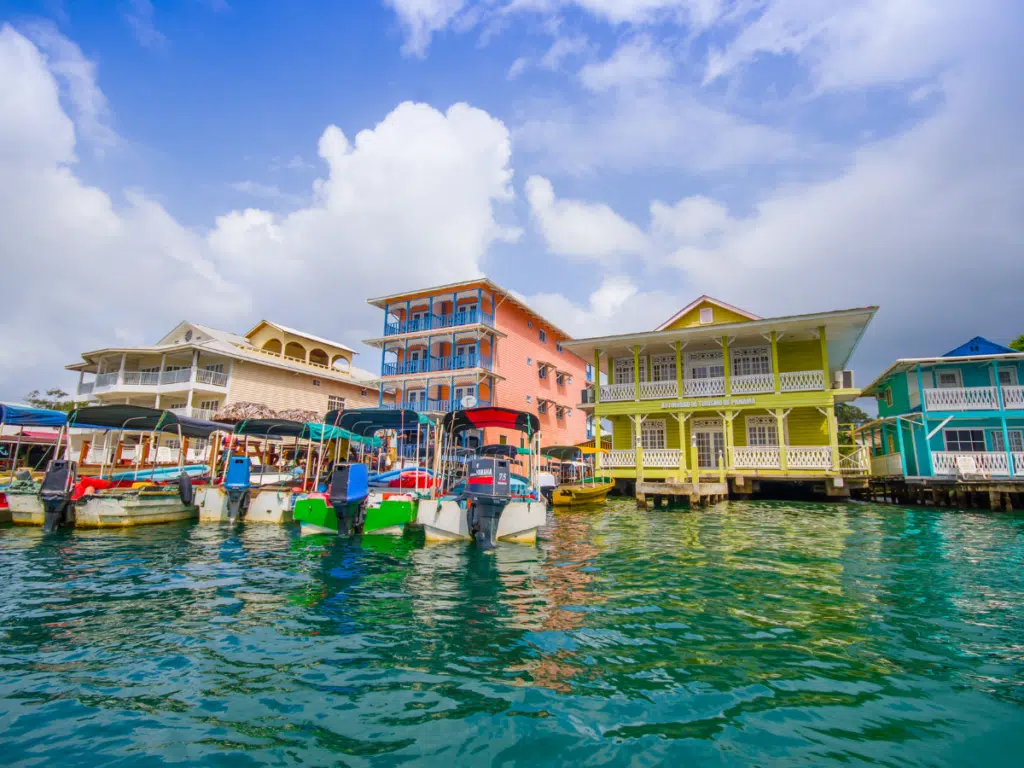
Getting to Panama
Whether you’re traveling overland to Panama from Costa Rica or Colombia or flying in directly from home, there are a number of ways to access the country. Not all of them are the most budget-friendly, but you’ll have no lack of options to choose from when deciding how to explore the country.
Flying To Panama
If you’re flying internationally into Panama, you’ll likely land at Panama Tocumen International Airport (PTY) in Panama City. PTY is one of the largest airports in Central America, and you can find great flight deals to Panama City from many destinations worldwide.
Panama City is a great place to start your adventure backpacking Panama, as it has a large bus terminal where you can find a bus going just about anywhere in the country.
Overland Travel To Panama
From Costa Rica
The international airport in the Costa Rican capital of San José can sometimes offer more affordable or convenient flights than Panama City. If you’re looking for flight deals – or just looking to also enjoy some time in Costa Rica before heading to Panama, than traveling overland between Costa Rica and Panama is your best bet.
The most popular Costa Rica-Panama border crossing is on the Caribbean Coast of Costa Rica, about an hour south of the laidback beach town of Puerto Viejo de Talamanca. The border crossing experience here tends to be an easy one.
Read More: Puerto Viejo de Talamanca, Costa Rica: Ultimate Travel Guide
From Colombia
The notoriously impassable Darien Pass between Colombia and Panama makes traditional overland travel from South America to Central America impossible. Instead, if you’re traveling from Panama to Colombia, the best way to travel is by sea via the San Blas Islands. You can join a 5-day sailing tour or a 4-day speed boat trip with San Blas Adventures.
If a multi-day trip to the San Blas Islands is out of your budget or not of interest to you, you’ll need to catch a flight from Colombia to Panama – or visa versa – instead.
Getting Around Panama
If you’re backpacking Panama, you’ll be happy to know there is a vast network of buses that will take you around the country, in comfortable conditions and at an affordable cost. It’s by far the best way to explore the country on a backpacker’s budget.
If you are short on time, you can also fly between many of the major towns and cities in Panama, but this will be more costly. The largest concentration of flights connects through Panama City, meaning it will be your flight hub if you plan on catching flights to and from other cities across the country.
Read More: 10 Best Cities in Panama For Travelers
Travel Essential
Don’t head out on your adventure without comprehensive travel insurance! Good travel insurance may cover lost or stolen gear, medical emergencies, delayed or canceled flights, and more. Check out the policies available from SafetyWing or compare plans using Visitors Coverage.
Safety and Solo Travel in Panama
Overall, I felt safe while backpacking Panama, even as a solo female traveler. The locals I encountered along the way were all very friendly and helpful. Like most of Central America, one of the most common forms of crime you’ll run into here is petty theft and pickpocketing. However, Panama is comparatively a very safe destination for travel.
We recommend always traveling with comprehensive travel insurance for your personal safety and the safety of your belongings while you’re on the road – SafetyWing has been our go-to for years, though we also like to check prices and plans with Visitors Coverage before we book.
After years on the road, we also have a few important items of travel gear we always carry with us to keep us safe. This is what we always carry:
- An inexpensive travel first aid kit for bumps and scrapes on the road or on adventures
- S-biner micro-locks are my favorite piece of travel safety gear, by far. Inexpensive and easy to use, they’re perfect for keeping zippers clipped together, a great deterrent for pickpockets.
- Luggage locks with flexible hooks to keep luggage locked when traveling or when leaving it in a hostel or hotel room
- A tiny personal alarm to carry on yourself at all times is now popular with female travelers. These take up no space, are totally discreet, and can be a true lifesaver for your peace of mind on the road
Lora Pope
Lora is a full-time digital nomad on a quest to visit every country and pet as many dogs as possible. Over the last 15 years, she has traveled solo to 70+ countries and six continents. She currently calls Puerto Vallarta, Mexico home, where she runs the website Take Me To Puerto Vallarta.

